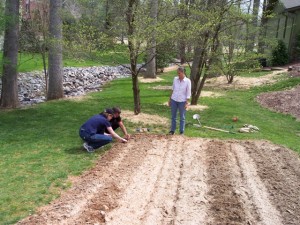* Asparagus: Grows best in full sun and non-soggy, somewhat sandy soil. I like it cut into one-inch pieces and stir fried raw with sesame oil and a little sliced ginger (top with toasted sesame seeds). Or, brush with olive oil and crushed garlic and grill whole spears on the bar-b.
* Bamboo Shoots: We have a good sized stand of bamboo that was on the property when we moved here, so I guess bamboo will be my contribution to the lineage of Yeager Roots. Not all varieties of bamboo shoots are edible (or tasty), so do your homework first. We boil ours to remove the bitterness, then sauté them in butter and a little sherry or sweet vermouth for flavor. Also, be advised that many varieties of bamboo are highly invasive and can be toxic if eaten in large amounts.
* Bunching Onions: This is a variety of onion that grows in clumps and multiplies on its own, and they are hardy in the ground even in fairly cold climates. The bulbs themselves are fairly small and pinkish in color (at least the ones I grow). I like to pickle them as something a little unusual for the relish tray…or in the martini glass.
* Garlic: As the saying goes, “If your lover doesn’t like garlic, get a new lover.” Garlic is a healthful perennial, although it’s often grown and harvested as an annual. Here’s how to keep it coming back every year. I like to rub a whole head of unpeeled garlic with olive oil, wrap it in aluminum foil, and stick it in the oven or on the grill for an hour or so when I’m cooking something else; squirt the warm, creamy pulp of each clove onto a cracker or piece of bread for a heavenly appetizer.
* Horseradish: As long as you harvest just the side roots, horseradish taproots will continue to produce a new harvest every year. To use as a condiment, clean and peel roots; cut into small chunks, and grind in a blender or food processor with a little water to the desired consistency. Add 1/2 teaspoon of salt for each cup of blended horseradish, and 2 or 3 tablespoons of white vinegar; seal and store in the refrigerator.
* Kale and Collard Greens: Perennial varieties will grow in many climates, and are among the healthiest of all vegetables. I eat greens at least once a week, and find that the secret is to not overcook them. Chop greens into half-inch strips and plunge into a pot of boiling, salted water for 10-15 minutes; remove and dress with butter/olive oil, vinegar/lemon juice and salt or feta cheese. And you thought you didn’t like greens.
* Radicchio: Think you can’t grow any perennial vegetables in your garden? Don’t be radicchio! Seriously, radicchio (aka “Italian chicory”) will come back every year in most climates if you don’t dig it up for blanching, as some chefs do. I like to add young, raw leaves to spice up a tossed salad, or grill older bunches (brushed with olive oil) to remove some of the bitterness.
* Rhubarb: Prefers colder climates, well-drained soil, and part-shade. Strawberry-rhubarb pie is hard to beat, but I also like to make rhubarb sauce instead of apple sauce: Cook two cups of inch-long pieces of cut up rhubarb stems in one-half cup of water until totally broken down, then add sugar and cinnamon to taste.


Strawberry-rhubarb pie, say no more. I’m sold. Get planting girl!
Let’s head out to the Farmer’s Market. We need rhubarb and lemon grass. Get your shoes!